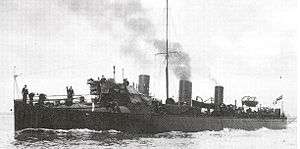Brazen-class destroyer
The Brazen class formed part of a general class of forty turtleback destroyers capable of 30 knots built around the end of the 19th and the start of the 20th century for the Royal Navy.
 HMS Recruit in 1896 | |
| Class overview | |
|---|---|
| Operators: | Royal Navy |
| Built: | 1896 |
| Completed: | 4 |
| Lost: | 1 |
| Scrapped: | 3 |
| General characteristics | |
| Type: | Destroyer |
| Speed: | 30 knots (56 km/h) |
| Notes: | Re-classified as C-class destroyers in 1913 |
The Admiralty had specified the general design and specification of the destroyers but left it to the builders to handle the detail. As a result, although the destroyers were all similarly capable there were differences between them in terms of exact dimensions, type of boiler and engines and the number of funnels. They were seaworthy and well built but suffered from being lively which meant they were uncomfortable in heavy seas. Although specified for 30 knots this was with a light load, and in service 27 knots was normal.
In 1913 all the three-funnelled destroyers were reclassified as C-class destroyers.
Ships
| Name | Launched | Fate |
| HMS Brazen | 3 July 1896 | Broken up in 1919[1] |
| HMS Electra | 14 July 1896 | Broken up in 1920[1] |
| HMS Recruit | 22 August 1896 | Torpedoed in 1915[1] |
| HMS Vulture | 22 March 1898 | Broken up in 1919[1] |
References
- "Brazen class at BattleshipsCruisers.co.uk". Retrieved 2009-04-03.